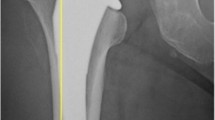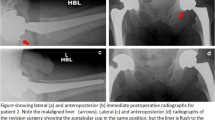Abstract
The aim of this study was to compare the component positioning of Birmingham Hip Resurfacings implanted through a posterolateral approach with those inserted via a direct lateral approach. Sixty-four hip resurfacings for osteoarthritis were carried out by a single surgeon: 23 through a direct lateral approach and 41 through a posterolateral approach. No significant differences in implant survival, Oxford Hip Scores or complications were found. The mean abduction angle for the acetabular component was lower (p < 0.007) with a posterior approach (mean: 37.5°; range 26–50°) than the lateral approach (mean: 43°; range 30–56°). There was no significant difference in stem orientation, either in flexion/extension or varus/valgus, between the two groups. This study demonstrates that components can be implanted in an acceptable orientation through either approach but that the posterior approach results in greater closure of the acetabular component.
Résumé
Le but de cette étude est de comparer la position de l’implant de resurfaçage de la hanche de type Birmingham, mis en place après abord postéro externe comparé à la voie directe latérale. 64 resurfaçages de hanche pour coxarthrose ont été réalisés par un seul chirurgien, 23 par voies latérales et 41 par voies postéro latérales. Il n’y a pas de différence significative dans la survie de l’implant, ni dans le score d’Oxford et les complications. La position du composant acétabulaire est beaucoup plus basse (p < 0.007) par abord postérieur (angle moyen 37.5° entre 26 à 50) que par voie latérale (angle moyen 43° entre 30 à 56). Il n’y a pas de différence significative dans l’orientation de la pièce fémorale ni en flexion, ni en extension et ni en varus ni en valgus. Cette étude démontre que les composants peuvent être implantés de façon acceptable par une des deux abords mais, l’abord postérieur entraîne une position plus basse de l’implant acétabulaire.



Similar content being viewed by others
References
Amstutz HC, Beaulé PE, Dorey FJ, Le Duff MJ, Campbell PA, Gruen TA (2004) Metal-on-metal hybrid surface arthroplasty: two to six-year follow-up study. J Bone Joint Surg Am 86(1):28–39
Beaulé PE, Campbell P, Shim P (2007) Femoral head blood flow during hip resurfacing. Clin Orthop Relat Res 456:148–152
Bradley GW, Freeman MA, Revell PA (1987) Resurfacing arthroplasty. Femoral head viability. Clin Orthop Relat Res 220:137–141
Daniel J, Pynsent PB, McMinn DJW (2004) Metal-on-metal resurfacing of the hip in patients under the age of 55 years with osteoarthritis. J Bone Joint Surg Br 86(2):177–184
Dawson J, Fitzpatrick R, Carr A, Murray D (1996) Questionnaire on the perceptions of patients about total hip replacement. J Bone Joint Surg Br 78(2):185–190
Forrest N, Welch A, Murray DA, Schweiger L, Hutchison J, Ashcroft GP (2006) Femoral head viability after Birmingham resurfacing hip arthroplasty: assessment with use of [18f] fluoride positron emission tomography. J Bone Joint Surg Am 88(Suppl 3):84–89
Freeman MA (1978) Some anatomical and mechanical considerations relevant to the surface replacement of the femoral head. Clin Orthop Relat Res 134:19–24
Gautier E, Ganz K, Krügel N, Gill T, Ganz R (2000) Anatomy of the medial femoral circumflex artery and its surgical implications. J Bone Joint Surg Br 82(5):679–683
Hardinge K (1982) The direct lateral approach to the hip. J Bone Joint Surg Br 64(1):17–19
Khan A, Yates P, Lovering A, Bannister GC, Spencer RF (2007) The effect of surgical approach on blood flow to the femoral head during resurfacing. J Bone Joint Surg Br 89(1):21–25
Kwon MS, Kuskowski M, Mulhall KJ, Macaulay W, Brown TE, Saleh KJ (2006) Does surgical approach affect total hip arthroplasty dislocation rates? Clin Orthop Relat Res 447:34–38
Minns RJ, Crawford RJ, Porter ML, Hardinge K (1993) Muscle strength following total hip arthroplasty. A comparison of trochanteric osteotomy and the direct lateral approach. J Arthroplasty 8(6):625–627
NJR Steering Committee. National Joint Registry for England and Wales—3rd annual clinical report. February 2006. The NJR Centre, Hemel Hempstead, UK
Nötzli HP, Siebenrock KA, Hempfing A, Ramseier LE, Ganz R (2002) Perfusion of the femoral head during surgical dislocation of the hip. Monitoring by laser Doppler flowmetry. J Bone Joint Surg Br 84(2):300–304
Pajarinen J, Savolainen V, Tulikoura I, Lindahl J, Hirvensalo E (2003) Factors predisposing to dislocation of the Thompson hemiarthroplasty: 22 dislocations in 338 patients. Acta Orthop Scand 74(1):45–48
Pollard TCB, Baker RP, Eastaugh-Waring SJ, Bannister GC (2006) Treatment of the young active patient with osteoarthritis of the hip. A five- to seven-year comparison of hybrid total hip arthroplasty and metal-on-metal resurfacing. J Bone Joint Surg Br 88(5):592–600
Steffen RT, Smith SR, Urban JPG, McLardy-Smith P, Beard DJ, Gill HS, Murray DW (2005) The effect of hip resurfacing on oxygen concentration in the femoral head. J Bone Joint Surg Br 87(11):1468–1474
Stephenson PK, Freeman MA (1991) Exposure of the hip using a modified anterolateral approach. J Arthroplasty 6(2):137–145
Sugamoto K, Ochi T, Takahashi Y, Tamura T, Matsuoka T (1998) Hemodynamic measurement in the femoral head using laser Doppler. Clin Orthop Relat Res 353:138–147
Treacy RBC, McBryde CW, Pynsent PB (2005) Birmingham hip resurfacing arthroplasty. A minimum follow-up of five years. J Bone Joint Surg Br 87(2):167–170
Wagner H (1978) Surface replacement arthroplasty of the hip. Clin Orthop Relat Res 134:102–130
Acknowledgments
Conflict of interest statement
No benefits in any form have been received from a commercial party directly or indirectly related to the subject of this article.
Author information
Authors and Affiliations
Corresponding author
Rights and permissions
About this article
Cite this article
Myers, G.J.C., Morgan, D., McBryde, C.W. et al. Does surgical approach influence component positioning with Birmingham Hip Resurfacing?. International Orthopaedics (SICO 33, 59–63 (2009). https://doi.org/10.1007/s00264-007-0469-8
Received:
Revised:
Accepted:
Published:
Issue Date:
DOI: https://doi.org/10.1007/s00264-007-0469-8




